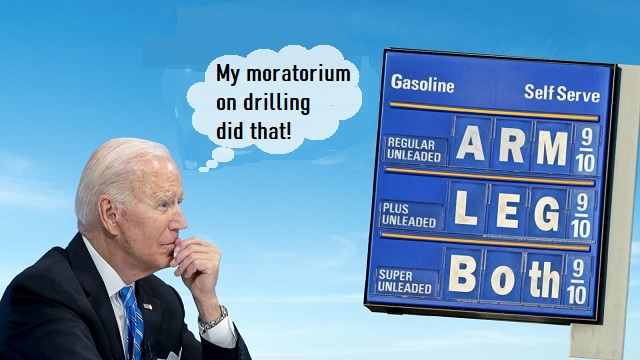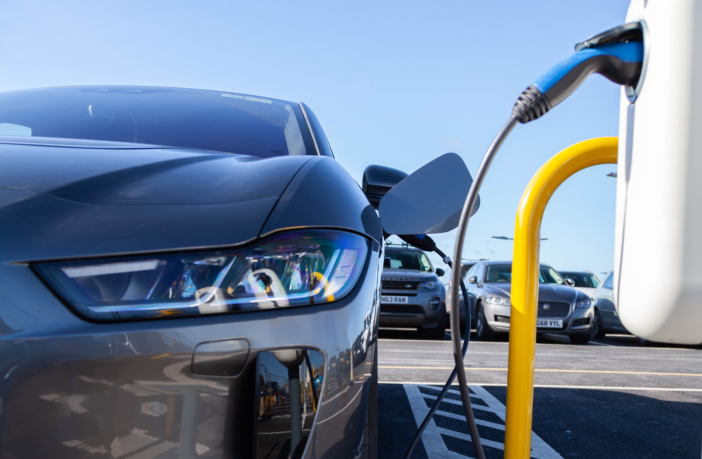
The most frustrating thing about Biden’s oil and gas crisis
Opinion by Noah Rothman – Search (bing.com)
Have the crippling sanctions imposed on Russia as a response to its war of conquest
in Ukraine backfired on the West? That concern is being expressed across Europe and, increasingly, it is one that President Joe Biden’s administration shares. (Not to mention the mechanics reluctance to work on them and rejecting the cost of new tools.)
Bloomberg News reported last week that the White House was “initially impressed”
by the impact the post-invasion sanctions regime was having on the Russian economy
and by Western firms’ willingness to voluntarily divest from the Russian marketplace.
But, as that story points not, not only are those sanctions “exacerbating inflation” and “punishing ordinary Russians more than Putin or his allies,” the Russian energy sector — the country’s largest revenue generator by far — hasn’t suffered much at all.
The Kremlin is generating more revenue than it spends making war against Ukraine.
To the contrary, as The New York Times reported last Monday, “Russia’s revenues from fossil fuels” have soared over the course of the war. While the country’s overall energy exports have declined by volume, the report notes that “surging prices have more than canceled out the effects of that decline.” The Kremlin is generating more revenue than it spends making war against Ukraine, and new, stricter sanctions targeting Russian energy that are due to come online soon may come too late to shape the outcome of that conflict.
Countering the influence of Russian energy is a fiendishly complex problem. It’s been decades in the making, and it cannot be solved overnight. Moreover, the West’s eagerness to outsource its energy needs to foreign producers ensures that we have no one to blame but ourselves.
Putting downward pressure on energy prices is, I’d argue, Biden’s most urgent priority
at the moment, not only to limit Russia’s options in Ukraine but also to ease domestic inflation (because the cost of all goods is exacerbated by high energy costs). Toward that end, Biden has adopted two seemingly contradictory approaches to the problem.
On the one hand, he blames “Putin’s price hike” for Americans’ reduced purchasing power.
On the other, he accuses America’s fossil-fuel producers of greed for making profits off a high-demand product that is experiencing scarcity.
President Biden demands oil companies explain lack of gasoline.
“At a time of war — historically high refinery profit margins being passed directly onto American families are not acceptable,” the president wrote in a letter to U.S. oil refining companies like Exxon Mobil and Chevron. These “companies must take immediate actions to increase the supply of gasoline, diesel, and other refined products,” he continued.
But increased domestic fossil-fuel production wouldn’t just help ease inflationary
pressure on the economy; exporting domestically produced fuel would help offset the world’s dependence on petrostates and their illiberal governments. Unfortunately, we’ve spent the better part of the last half-decade limiting our ability to respond to exigencies like the war in Europe.
At the end of 2018, the United States produced over 20 million barrels of petroleum products (crude oil, natural gas and refinery derivatives) per day. In 2019, the U.S. outpaced Saudi Arabia’s output for the first time in decades, and forecasts estimated
that the U.S. would become a net exporter of energy by 2022.
Also in 2019, Iranian-backed forces executed a sophisticated, multi-drone strike
on a Saudi oil-processing plant, the culmination of a series of Iranian-linked strikes
on oil-producing targets in the kingdom and in the Strait of Hormuz.
How the Strait of Hormuz could potentially lead to war with Iran.
In years prior, an attack on one of the world’s most productive refineries would have crippled the global economy and may even have necessitated an armed response by the countries dependent upon that supply. But the United States was able to stabilize global markets by releasing an unspecified amount from the country’s strategic reserves, and thus the attack barely made an economic ripple.
Not only did American energy production capacity ballast the global economy,
it may have also prevented violence. Much has changed in just a few intervening years. As National Review’s Jim Geraghty observed, the onset of the pandemic artificially truncated global energy consumption, which ensured that Americans didn’t notice as the nation dramatically curtailed its refinery capacity. A 2019 accident crippled the East Coast’s largest refinery, the Philadelphia Energy Solutions plant, and it was permanently mothballed in 2020. Over the course of 2020, that diabolical year, five more American refineries stopped producing petroleum products. Most of those facilities have transitioned or are currently transitioning to alternative fuels and biofuels processing facilities.
Reversing the decline of America’s domestic refining capabilities is just one facet of a comprehensive campaign to combat the influence of the world’s anti-Western petrostates.
Reversing the decline of America’s domestic refining capabilities is just one facet of a comprehensive campaign to combat the influence of the world’s anti-Western petrostates. But an all-hands-on-deck approach to addressing the global energy deficit that is hurting Americans and advancing Russian interests would require the Biden administration to take many measures they’ve so far avoided.
To the White House’s credit, the administration has already taken a few welcome steps
in that direction, albeit belatedly. In April, the administration loosened an executive order that put a stop to all new leases for oil and gas exploration on federal land, and also the president has dropped his crusade to anathematize the Saudi Kingdom and its crown prince, Mohamed bin Salman, a concession that corresponded closely with a long-delayed decision by the Saudi-led OPEC cartel to ramp up production in July and August.
There is, however, plenty the White House still refuses to do to ease the pressure on American wallets. The administration so far has not abandoned its objection to providing drilling leases in the Artic National Wildlife Refuge. It won’t rescind a day one executive order barring federal agencies from providing fossil fuel producers with “subsidies.”
It won’t allow three already approved offshore oil leases to move forward, taking millions of acres of exploitable deposits off the table.
The campaign to isolate Moscow and decouple the global energy market from reliance on Russian exports is proceeding in fits and starts. Remarkable progress toward that goal has been achieved in a staggeringly short period of time. But it was never going to be possible to wholly offset the world’s demand for Russian energy quickly enough to prevent petrodollars from fueling Moscow’s war in Europe.
There is one alternative to the energy produced and exported by totalitarian states, and that is the energy produced and exported by liberal, democratic states. However, the West has spent decades trading away its productive capacity in service to the idea that green energy was a sufficient replacement for fossil fuels. And where we needed to supplement our energy needs, we counted on the world’s most egregious human rights violators to provide the rest. This was always a devil’s bargain. Today, Ukraine is absorbing much of the cost of the West’s hunger for Russian energy, but its people won’t be the last to suffer for our delusions.

What happens to electric vehicle batteries when they die?
– Electric & Hybrid Vehicle Technology International.
Nor’Adila Hepburn – Search (bing.com)
While driving electric vehicles is a step towards a greener future, the car batteries that power them are not as sustainable. Though the battery is at the heart of any EV, most are made from lithium-ion and have a limited lifespan that starts to degrade from the first time you charge them. So what happens when they reach capacity?
The cycle of charging and discharging causes them to lose energy and power. The more charge cycles a battery goes through, the faster it will degrade. Once batteries reach 70 or 80% of their capacity, which happens around either 5 to 8 years or after 100,000 miles of driving, they have to be replaced, according to Science Direct.
Due to electric vehicles’ rising popularity, it goes without saying that their battery
waste will become a major issue. Experts estimate that 12 million tons of batteries will be thrown away by 2030, The Guardian reported. The conundrum that manufacturers and consumers have is that although they can be recycled, there are not enough facilities to handle them. To date, there are only four lithium-ion recycling centers in the United States (via WCNC). However, this number must grow exponentially — in the next few years as Industry experts predict there will be 85 million electric vehicles on the road by 2030
(via ScienceDirect).

Recycling Is Complex
© Blue Planet Studio/ShutterstockEV car
Recycling car batteries is an arduous and dangerous process that involves splitting them apart to extract the metals inside. To do it, recyclers typically utilize two techniques: pyrometallurgy and hydrometallurgy, Science reported. Pyrometallurgy, the preferred method, shreds the battery down and then a burning process takes the metal out. With hydrometallurgy, the battery is submerged in acid to separate the metal. With either method, there is a risk of toxic fume emissions or an outright explosion (via Science).
There are other issues too. Unlike other compact batteries, EV batteries weigh about 960 pounds, according to Wired. If you are an EV manufacturer, finding proper transportation and storage could prove a logistical nightmare.
They are also a fire hazard if and when stored together. A report by the Environmental Protection Agency found that between 2013 and 2020, more than 240 lithium-ion battery fires broke out across 64 municipal waste facilities.
And that’s not all. If these batteries find their way to landfills, harmful toxins such as
lead and nickel can contaminate soil and groundwater supplies (via AZO CleanTech).

Companies Are Giving EV Batteries A Second-Life
© Herr Loeffler/Shutterstockcompanies and EVs
Outside of recycling, old EV batteries can be repurposed as a renewable energy
source for homes and businesses. Even if they have a reduced storage capacity,
can be reused to store wind and solar energy, according to Innovative News Network.
This can extend their life cycle by another seven to 10 years.
A good example of this is Toyota’s initiative to sustainably power Yellowstone Park.
The car company equipped the landmark with solar panels powered by batteries that
once belonged in Camry Hybrids, replacing diesel generators (via Toyota).
Toyota was not the only one, however. A Spanish company ran an experiment where
it converted used lithium-ion batteries into second-life batteries with great success. In particular, it proved the ability to use recycled electric vehicle batteries to help power one of the local electricity plants in the case that there is a temporary shutdown (via Enel).
Electrical disruptions caused by squirrels – Wikipedia
The $7 Trillion Cost Of Upgrading The U.S. Power Grid | OilPrice.com
Read this next: 12 Cars That Were Way Ahead of Their Time
Do you believe the current Electric car / Battery technology is appropriately designed for the fossil fuel problems that the world faces now?
Definitely not 62%
Definitely 7%
Possibly 17%
I’m not sure 9%
Other / No opinion 5%
The Texas Republican Party just voted ‘overwhelmingly’ to reject the legitimacy of Biden’s 2020 election win, and is trying to stir up fear about ‘possible fraud’ in the upcoming midterms (msn.com)
1 month after the Uvalde shooting, here are 5 questions that are still unanswered
Carole.King.and.James.Taylor.live.at.the.Troubadour.2010.
2022 U.S. Open Highlights: Round 4, Down the Stretch.
2022 U.S. Open Highlights: Round 4, Extended.
